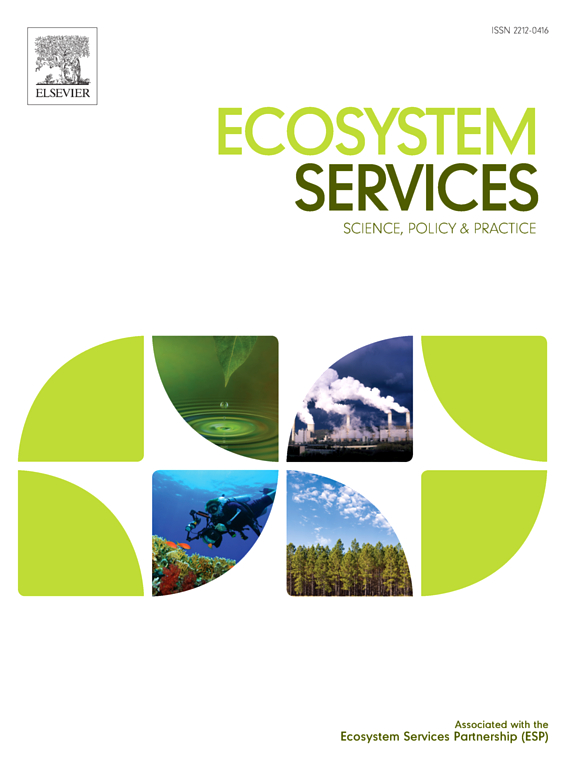Unveiling the potential supply of cultural ecosystem services on the Qinghai-Tibet Plateau: Insights from tourist hiking trajectories
IF 6.6
2区 环境科学与生态学
Q1 ECOLOGY
引用次数: 0
Abstract
The Qinghai-Tibet Plateau (QTP) is globally recognized as a prime tourism destination, renowned for its unique plateau landscapes and rich cultural heritage. Assessing the supply of cultural ecosystem services (CES) in this vast, data-scarce region holds paramount significance for local sustainable tourism development. However, limited research has addressed this issue. This study harnessed over 60,000 outdoor hiking trajectories from tourists and outdoor enthusiasts (2017–2020) to map both the current and potential CES provision across the QTP. Our findings show that only about 16 % of the plateau currently offers CES experiences for tourists. This supply is unevenly distributed, with 39 % of the tourist visits concentrated in the coniferous forest ecoregions of eastern QTP. Using robust random forest models and advanced AI techniques, we identify key biophysical factors—landscape diversity and water bodies—as well as socioeconomic predictors, such as proximity to hotels and roads, that influence CES availability. We estimate that an additional 4.8 % of the QTP’s area could offer high CES supply, contrasting with the current 1.2 % realized CES supply. These high-potential zones are promising candidates for new tourist attractions and could benefit from targeted infrastructure investment. Our study highlights the potential of tourist-contributed Volunteered Geographic Information (VGI) in assessing cultural services and informing tourism planning.

揭示青藏高原文化生态系统服务的潜在供给:来自游客徒步旅行轨迹的见解
青藏高原是全球公认的旅游胜地,以其独特的高原景观和丰富的文化遗产而闻名。评估这一广阔而缺乏数据的地区的文化生态系统服务(CES)供应对当地的可持续旅游发展具有至关重要的意义。然而,有限的研究已经解决了这个问题。这项研究利用了游客和户外爱好者(2017-2020年)的6万多条户外徒步旅行轨迹,绘制了整个QTP地区目前和潜在的消费电子产品供应地图。我们的研究结果表明,目前只有约16%的高原地区为游客提供CES体验。客源分布不均匀,39%的游客集中在东部针叶林生态区。利用强大的随机森林模型和先进的人工智能技术,我们确定了影响CES可用性的关键生物物理因素——景观多样性和水体——以及社会经济预测因素,如与酒店和道路的接近程度。我们估计,与目前1.2%的实现CES供应相比,QTP面积的4.8%可以提供高CES供应。这些高潜力地区有望成为新的旅游景点,并可能受益于有针对性的基础设施投资。我们的研究强调了游客贡献的志愿地理信息(VGI)在评估文化服务和为旅游规划提供信息方面的潜力。
本文章由计算机程序翻译,如有差异,请以英文原文为准。
求助全文
约1分钟内获得全文
求助全文
来源期刊

Ecosystem Services
ECOLOGYENVIRONMENTAL SCIENCES&-ENVIRONMENTAL SCIENCES
CiteScore
14.90
自引率
7.90%
发文量
109
期刊介绍:
Ecosystem Services is an international, interdisciplinary journal that is associated with the Ecosystem Services Partnership (ESP). The journal is dedicated to exploring the science, policy, and practice related to ecosystem services, which are the various ways in which ecosystems contribute to human well-being, both directly and indirectly.
Ecosystem Services contributes to the broader goal of ensuring that the benefits of ecosystems are recognized, valued, and sustainably managed for the well-being of current and future generations. The journal serves as a platform for scholars, practitioners, policymakers, and other stakeholders to share their findings and insights, fostering collaboration and innovation in the field of ecosystem services.
 求助内容:
求助内容: 应助结果提醒方式:
应助结果提醒方式:


